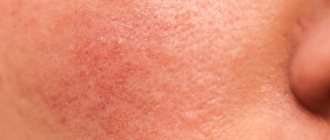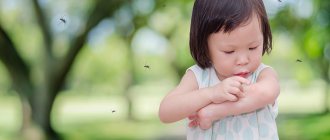- What is a sweet allergy?
- Causes of allergies to sweets
- Who is at risk
- Allergy to sweets: symptoms
- How does a sweet allergy manifest in children?
- What does a sweet allergy look like in pregnant women?
- Diagnosis of allergy to sweets
- Allergy to sweets: how to treat
What is a sweet allergy?
A pathology such as an allergy to sweets occurs in all categories of the population, but mainly occurs in children. The active component that provokes an allergic reaction is sucrose. Once in the gastrointestinal tract, this substance is difficult to digest, stimulating fermentation processes. As a result, food breakdown products and animal proteins enter the blood, triggering the production of immunoglobulin and causing an inflammatory reaction. Sweet intolerance cannot be called an allergy in the classical sense, since it does not imply the body’s sensitivity directly to sucrose. Pathology occurs against the background of incorrect functioning of the gastrointestinal tract and weak local immunity.
Vinikli nutrition - consult a doctor
To make an appointment for a consultation, call or fill out the return form:
(050) 301-99-26 (067) 446-11-79
Damn,
Your request has been successfully sent!
A call center specialist will contact you as soon as possible to clarify all the details.
Sweet allergies are rarely chronic. The pathology is aggravated by periods when consuming sweets in large quantities. With moderate consumption of confectionery products, the disease does not cause discomfort to a person. Pathology develops in childhood, which is due to the instability of the immune and digestive systems. In most cases, an allergy to sweets in children occurs at the age of 1.5-2 years and disappears by 7-8 years, subject to diet (restrictions in the diet of confectionery products). In the future, an exacerbation of childhood illness is possible, but this is usually associated with overeating and poor nutrition.
Experts' opinion
According to the results of clinical studies, which involved 50 children aged 0 to 5 years, the products were proven to be highly effective, safe and tolerable for daily skin care of children with mild to moderate forms of atopic dermatitis and during remission, accompanied by a decrease in the quality of life of patients . As a result of therapy, including the use of lip balm, a decrease in the activity of the inflammatory process, a decrease in dryness, itching and flaking was noted.
Sources:
- Yukhtina N.V., Modern ideas about atopic dermatitis in children
- Kamasheva G.R., Khakimova R.F. Valiullina S.A., Methods for assessing the severity of atopic dermatitis in young children, Dermatology journal, 2010
- Kovyazina N.A., Fedosimova N.A., Illek Ya. Yu. Diagnosis of atopic dermatitis in young children, Vyatka Medical Bulletin, 2007
Causes of allergies to sweets
The mechanisms that provoke an allergic reaction lie in the composition of confectionery products. There is a misconception that sweet allergies are caused by sugar, which by its nature is a carbohydrate. Unlike proteins and fats, carbohydrates do not have allergenic properties. Therefore, glucose is relatively safe for the human immune system and cannot be considered the main cause of allergies. Pathological processes are provoked by animal proteins (in particular, albumin) and certain types of fats contained in flour and confectionery products. Also, allergies are often caused by emulsifiers, dyes, flavors and other food additives. Absorbed into the blood along with nutrients, they have a detrimental effect on the immune system.
Biological causes of allergies include hereditary predisposition. About half of food allergies are passed on to children from their parents. Moreover, it is absolutely not necessary that both the father and mother have an allergy to sweets. It is enough for at least one parent to suffer from pathology. There is a possibility of a child inheriting a disease, even if the mother or father had it in childhood. Under such circumstances, sweet allergy in adults is in a chronic stage and is easily transmitted at the genetic level.
Almost any product containing a large amount of glucose can cause an allergic reaction. The following products pose the greatest danger to allergy sufferers:
- chocolate;
- honey;
- caramel;
- sweet baked goods (cakes, pastries, cookies);
- candies;
- condensed milk;
- jam, jam;
- marmalade;
- meringue, marshmallow.
Diet for allergies in a child
Older children who have already switched to the “common table” should exclude:
- soda;
- jelly Bean;
- chocolate;
- jams and preserves from raspberries, strawberries;
- citrus;
- as well as all products containing non-natural ingredients.
Severe allergies may limit your diet to a few foods, since in such a state any familiar component can cause aggravation. Therefore, it is very important to adhere to medical recommendations.
Who is at risk
The risk of development is highest in preschool children. This is explained by the instability of the children's immune system to food irritants. If a child often consumes confectionery products, there is a high probability that he will develop a sweet allergy in the first 2 years of life. Risk factors that provoke pathology also include a woman’s diet during pregnancy. The mother's diet affects the baby's immunity, the development of the fetus's internal organs and systems. The predominance of sweets in a pregnant woman's menu often causes the baby to develop diathesis - an innate tendency to allergic reactions, provoked by abnormalities in intrauterine development.
People with atopic dermatitis are also at risk. This pathology is chronic and represents a hereditary tendency to allergic skin reactions. Irritation occurs due to mechanical impact or ingestion of certain foods. At the same time, an allergy to sweets often accompanies other forms of food allergies. People with this diagnosis often have allergies to citrus fruits, chocolate, and nuts.
The gastrointestinal tract plays an important role in developing the body's resistance to allergens. With various inflammatory and chronic processes in the organs of the digestive system, the risk of developing allergies increases significantly. With slow digestion, food particles begin to rot, and their breakdown products enter the bloodstream in the form of toxins. By poisoning the body, they activate its defense mechanisms. This leads to the active production of histamine, the main provocateur of allergic processes.
Hives from sweets
Urticaria from sweets is the mildest form of an allergic reaction. Although it also brings sufficient discomfort, as it is expressed:
- Rash;
- Blisters;
- Nodules;
- Spots.
It most often appears on the face and neck, but can also appear on any part of the body. Moreover, urticaria is not only a manifestation of allergies, it can also indicate more serious diseases of internal organs and systems.
Therefore, in case of any rash, you should contact the specialists of the Allergomed clinic. For many years, we have been helping people get rid of various allergic reactions, including allergies to sweets.
Allergy to sweets: symptoms
Manifestations of allergies occur within 30-60 minutes after eating sweets. Sometimes the body’s reaction is protracted and develops after 2-3 hours. The severity of symptoms depends on the amount of food eaten and the sensitivity of the immune system to allergens. The most severe reactions occur in children and people with weak immune systems. In this case, one cake eaten is enough to develop an allergy. All existing signs of a sweet allergy are conventionally divided into several categories.
- Gastrointestinal. The victim experiences pain in the abdominal cavity, accompanied by increased gas formation, loose stools, or vomiting. In case of a severe allergic reaction, the temperature may rise.
- Skin. Already 20-30 minutes after eating, the first rashes appear on the skin in the form of small red pimples, accompanied by itching. As the allergy progresses, the rash gets worse and the skin begins to peel. Red spots appear on the face and stomach. The hallmark sign of acute food allergies is hives. It manifests itself as numerous blisters that cause itching and burning.
- Respiratory. Symptoms in this category primarily affect the respiratory system. Already in the first minutes after eating, tingling and burning may occur in the oral cavity, which quickly leads to swelling of the laryngeal mucosa. The tumor blocks the airway, causing severe shortness of breath. Later, bronchospasms, runny nose, and dry cough are added to the symptoms described above.
An acute allergy to sweets develops within an hour after consuming an allergenic product and requires urgent hospitalization of the victim. In the absence of medical care, there is a high probability of developing Quincke's edema (giant urticaria). The most dangerous complication of a sweet allergy is anaphylactic shock. It leads to a drop in pressure and loss of consciousness. A patient with anaphylactic shock must be hospitalized immediately, otherwise the condition will be fatal.
Atopic dermatitis, adaptation disorders and intestinal dysbiosis
Atopic dermatitis (AD) is a chronic recurrent inflammatory skin disease manifested by intense itching, sympathetic skin reaction, papular rashes and severe lichenification in combination with other signs of atopy. AD usually occurs in early childhood, has age-related localization features, and is characterized by hypersensitivity to both allergens and nonspecific irritants. Blood pressure significantly affects the quality of life, can cause sleep disturbances, decreased activity, neurotic conditions and lead to the formation of bronchial asthma and, accordingly, disability [1, 9].
Among the etiological factors leading to the development of AD, sensitization to food allergens is indicated, especially in childhood. This is due to congenital and acquired dysfunctions of the digestive tract, improper feeding, early introduction of highly allergenic foods into the diet, intestinal dysbiosis, the presence of a high titer of opportunistic pathogenic flora (OPF), disruption of the cytoprotective barrier, etc., which contributes to the penetration of antigens from food gruel through the mucous membrane into the internal environment of the body and the formation of sensitization to food products [6, 7, 10].
Most allergic problems are related to the gastrointestinal (GI) tract to one degree or another. This especially applies to allergic dermatoses, including AD. More than 90% of all antigens with which a person comes into contact are constantly present or in transit in the intestine - this is where the main elements of antiallergic protection are located, and the intestinal wall contains a huge number of immunocompetent cells, which allows some researchers to consider the intestine one of the key organs of the immune system. If any disturbances occur in the barrier function of the gastrointestinal tract, various toxins and antigens that become allergens begin to enter the blood from the intestines.
Allergens can be waste products of opportunistic flora [4] and parasites living in the intestinal lumen, as well as food that has not undergone sufficient breakdown. They sensitize the patient’s body, promote the production of specific IgE antibodies and the subsequent release of histamine from mast cells, which determines the clinical picture of food allergy. As you know, the environment is abundantly populated by microorganisms. Many of them are not capable of coexistence with a macroorganism, others are saprophytes, and others are symbionts, i.e., organisms capable of coexisting with other biological species in an interconnected and mutually beneficial interaction. Symbionts are necessary for the normal functioning of the host organism.
Under normal physiological conditions, the human body contains hundreds of different types of microorganisms. The term “normal microflora” unites microorganisms isolated from the body of a healthy person: from the skin, mucous membranes of the upper respiratory tract, gastrointestinal tract and genitourinary system. The lower sections of the small and especially large intestines represent a reservoir of bacteria throughout the body.
Normal flora is considered to be a set of microorganism associations typical for a certain biological species, the natural life activity of which occurs in those organs and tissues of the macroorganism that communicate with the external environment. Normoflora performs the most important physiological and immunological functions in the macroorganism and forms a single whole with it.
The total number of intestinal bacteria reaches 1014 cells, which is almost an order of magnitude greater than the number of cells of all organs and tissues of the macroorganism. It has been shown that the natural form of existence of any microorganisms in nature is an immobilized state, i.e. 99.9% of bacteria in nature live in the form of microcolonies fixed to various surfaces [12].
Attachment of microbial cells to solid surfaces occurs in three stages: in the first stage, reversible adhesion occurs due to weak interactions; the second stage consists of nonspecific adhesion with the help of fimbriae and pili, including the formation of hydrogen and ionic bonds; at the third stage, the formation of adhesion-enhancing extracellular material (polysaccharides) occurs. Thus, a biofilm is formed, through which contact is made between the intestinal lumen and the mucous membrane.
The biofilm covering the intestinal mucosa, in addition to polysaccharides of microbial origin, consists of colonies of microorganisms, as well as mucin produced by goblet cells. Microorganisms in a biofilm are tens and hundreds of times more resistant to adverse factors compared to when they are in a free-floating state [12]. Unlike free-living bacteria, representatives of normal flora in the animal body are able to attach only to certain receptors of the skin and mucous membranes. The most numerous and diverse group of bacteria is the thick mucosal layer covering the inner surface of the digestive tract. The normal flora of the gastrointestinal tract for humans are bifidobacteria, lactobacilli and Escherichia coli with normal enzymatic activity. As part of a biofilm, these types of bacteria should normally constitute up to 99% of all intestinal microflora.
In addition to normal flora, saprophytic and opportunistic flora may be present in the human intestine. Saprophytic flora is represented by epidermal and saprophytic staphylococci, enterococci, yeast, neisseria and other types of bacteria. Intestinal UPF can be represented by hemolytic streptococci, Staphylococcus aureus, spore-forming anaerobes, lactose-negative enterobacteria, hemolyzing Escherichia coli, and Candida fungi. Normally, the amount of UPF should not exceed 103–106 CFU per 1 g of feces, or 10% of the total number of microbes [5].
The normal flora of the intestine is involved in many vital processes of the macroorganism, which, in turn, is its habitat.
How does a sweet allergy manifest in children?
Uncontrolled consumption of sweets is the main cause of allergic reactions in childhood. The child’s weak body is not able to digest the huge amount of glucose entering it, which leads to intoxication. Also, the pathology is often provoked by a hereditary tendency to allergic reactions - diathesis. This condition develops in a child in utero and manifests itself in the first years of life. If you follow the diet recommended by the pediatrician, diathesis disappears without a trace by primary school age (6-7 years).
Nutrition plays an important role in the formation of a baby’s immunity. Thus, an allergy to sweets in an infant is directly related to the diet of the nursing mother. If a woman often consumes sweet pastries, candies and other confectionery products, glucose enters the baby's stomach along with breast milk. To avoid the development of allergies in your baby, it is recommended to give up sweets at least in the first two months of feeding. An allergy to sweets in a child who is on a regular diet is also caused by diet. Parents are advised to replace desserts on their child's menu with fresh fruit.
A child's allergy to sweets develops quite quickly; the first signs are noticeable within 20-30 minutes after eating. The pathology is characterized by the following symptoms:
the appearance of red spots on the hands and face;
- increased body temperature;
- vomit;
- dry paroxysmal cough;
- drowsiness.
Can allergies be prevented?
An allergy to candy in a child is an unpleasant situation that parents often encounter. To prevent the disease you should:
- follow a diet, keep a food diary: write down all the foods consumed by the child. If an allergy is noticed, then exclude the product from the menu.
- reduce the amount of sweets, and also try to replace them with natural products - unsweetened fruits and berries.
- strengthen the child’s immunity: experts advise performing health-improving exercises, walking a lot in the fresh air, avoiding stress if possible (whims, hysterics contribute to a decrease in immunity), eating right, creating a balanced menu that excludes allergenic foods.
In addition, experts recommend not introducing sweets to your baby until the age of 3, and also not adding salt and sugar when introducing complementary foods.
What does a sweet allergy look like in pregnant women?
An allergy to sweets during pregnancy is a fairly common occurrence. The pathology develops against the background of a sharp change in hormonal levels, leading to a decrease in immunity. In addition, pregnant women's metabolic processes are disrupted, which often causes digestive problems. Despite the fact that an allergy to sweets during pregnancy is considered a completely normal condition, it cannot be ignored. When the first signs of illness appear, you should contact an allergist. An allergic reaction is characterized by the following symptoms:
- redness of the skin of the face, especially the cheeks;
- the appearance of a rash on the arms, thighs, abdomen, chest;
- severe itching of the skin;
- swelling of the affected areas.
Diagnosis of allergy to sweets
An allergist or an allergist-immunologist examines and treats patients with food allergies. Children's allergies are diagnosed by a pediatrician. Allergists use three main ways to evaluate patients with allergic reactions.
- Blood tests for immunoglobulin. After talking with the patient and clarifying the details of his outpatient card, the doctor sends the patient to the treatment room to collect a venous blood sample. Then the biological material undergoes laboratory analysis for antibody levels. To activate the process of immunoglobulin production, the suspected allergen is introduced into the blood serum. The result of the study is assessed using reagents that can bind to antigen-allergen bonds. Ig blood tests are the safest way to diagnose allergic reactions.
- Skin tests. To create favorable conditions for the development of the allergic process, the allergen is administered to the patient subcutaneously as an injection. Sometimes the irritant substance is applied in liquid form directly to the skin, but this method is less effective. After 2-3 hours, the doctor evaluates the result of the procedure. Skin tests are contraindicated in children under 3 years of age, so a child’s sweet allergy will be diagnosed exclusively through blood tests.
- Provocative tests. This technique is used least often, as it poses a danger to the patient’s health. After provocative tests, the patient remains in a medical facility for about a day under the supervision of doctors. The method is as follows: the patient consumes a certain amount of any sweet product, after which the doctor begins monitoring his condition. If allergy symptoms appear 30-60 minutes after eating, the preliminary diagnosis is confirmed.
Allergy to sweets: how to treat
Allergy therapy is based on limiting foods containing glucose in the diet. It is recommended to eat sweet fruits, vegetables, cereals, and savory baked goods. It is allowed to add sweeteners (fructose, etc.) to dishes and drinks. Parents need to exercise strict control over the diet of children who have been diagnosed with a sweet allergy. Treatment also involves taking medications to relieve symptoms. For allergies to sweets, patients are prescribed the following medications:
- antihistamines;
- enterosorbents;
- vasoconstrictor nasal sprays;
- hydrocortisone ointments.









